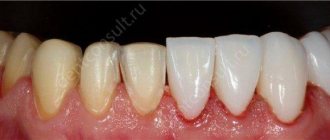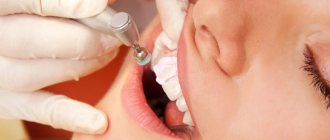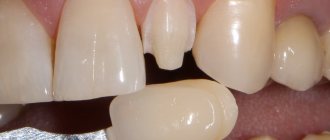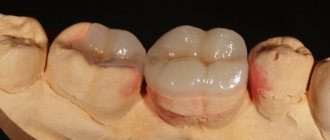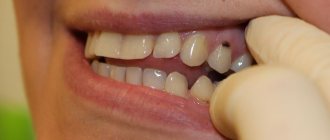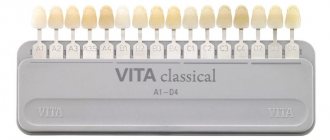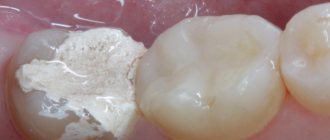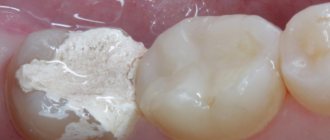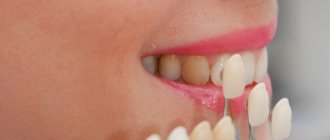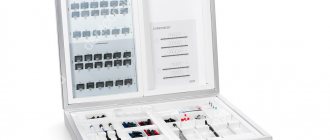Advantages over classic products
Dentists recommend E-MAX veneers to their patients for aesthetic restoration, since the products are endowed with quality indicators:
- The material has high strength , because it is a type of lithium silicate glass ceramics.
- Modern ceramic linings are produced by pressing. As a result of the absence of pores and tension in the material of the structure, it acquires a smooth, uniform surface.
This property allows the production of very thin veneers (thickness comparable to a contact lens). Thanks to this feature, there is no need to sharpen the teeth. - Fixed using dental glue , which protects the enamel from caries.
- The presence of a wide range of shades and transparency of the enamel is designed for a wide range of patients.
- Precise positioning of the structure on the tooth is achieved through 3D computer modeling, which eliminates all errors.
- The records are durable ; they do not fade or fade over time. Even after ten years, they will look like they were just made.
- Plaque does not accumulate on the onlays, and tartar does not form on them.
- The material is suitable even for allergy sufferers , has high biocompatibility and does not enter into chemical reactions with saliva and other liquids.
- There is no gum destruction around the restored area.
Conventional linings may have a number of disadvantages compared to E-MAX products:
- With insufficient care, food particles may get between the product and the dental element, which can trigger the development of caries.
- During installation, a mandatory manipulation is grinding off the protective layer of the unit being restored.
- Products can be made according to a template.
- Short service life (7 years with good care).
The characteristic features of conventional structures and those manufactured using E-MAX technology are given in the comparative table:
| Feature | E-MAX | Ceramics |
| Strength | High. The risk of chipping is minimal | Relative |
| Construction technology | CAD/CAM technology is used. The use of 3D modeling increases the accuracy of pad positioning | Manual creation from a cast or template |
| Installation | In some cases, fixation is possible without removing the enamel | Mandatory removal of enamel to the thickness of the plate |
| Aesthetics | Very high. The plates look natural. The color scheme matches the natural shade | High. Ceramic veneers are invisible on teeth |
| Lining life | From 15 years and older | On average 7-10 years |
| Cost in rubles | At least 20 thousand | From 10 thousand |
E-max veneers and crowns: reviews
When it comes to metal-free ceramic options for the manufacture of ceramic crowns, veneers or bridges, the choice is always between E-max and zirconium dioxide. Of course, there is also feldspathic ceramics, which, although it has very good aesthetics, still has very modest strength (which is why we are not considering it).
And to be brief, E-max is primarily about aesthetics, and zirconium dioxide is primarily about strength. Below we will compare these 2 types of metal-free ceramics according to these criteria and talk about the optimal indications for the use of each of them.
Aesthetics -
A veneer or ceramic crown on a tooth made from E-max has truly impeccable aesthetics. This is due to the fact that lithium disilicate glass ceramics have a high degree of transparency, which is almost identical to natural tooth enamel. Therefore, if you have high transparency of tooth enamel, a good dentist will offer you only E-max.
In addition, a very important factor that ensures an exact match in appearance of an artificial crown or veneer with neighboring teeth is the choice of a wide range of material shades. And here it must be said that the E-max ceramic system has a significantly larger range of shades, which significantly increases the dental technician’s chances of achieving an exact match of the color of artificial crowns with neighboring teeth (Fig. 18-22).
Clinical case No. 5 – before and after photos
Clinical case No. 6 – before and after photos
Aesthetics of zirconium dioxide crowns –
But the use of zirconium dioxide on the front teeth most often disappoints patients. This is due to the fact that, firstly, the zirconium frame has little light transmission (transparency), and secondly, when working with zirconium dioxide, the dental technician is more limited in the choice of color shades than when working with E-max. Ultimately, all this does not allow making crowns and veneers made of zirconium dioxide as similar as possible to real teeth.
Therefore , if you take a good look at most “before and after photos” of zirconium crowns and veneers, you will notice that in 90% of cases they will be quite different in color and transparency from the neighboring real teeth. Most often they will be completely opaque, and often have an unnatural bright white (milky) color. Although zirconium dioxide certainly does not reach E-max in aesthetics, this does not mean that veneers and crowns made from it can only be opaque and milky in color.
The fact is that zirconium dioxide blocks from different manufacturers are very different from each other. Dental clinics most often use white, opaque zirconium dioxide blocks for milling crowns (which is why the finished crowns look similar) due to their lower price. However, there are also translucent zirconium dioxide blocks, for example, Prettau® Anterior, which allow you to achieve aesthetics that are already quite acceptable for the front teeth.
Strength –
E-max ceramics has a fairly high strength - 360-400 MPa.
This is more than enough for single crowns on the front and posterior teeth, veneers and lumineers, as well as 3-unit bridges. However, bridges are made mainly only on the front teeth (the far support of the bridge should not be located further than the 5th tooth). In turn, zirconium dioxide has a strength of 1200 MPa, which is comparable to metal. Thanks to this, bridges of any length can be made from this material. Therefore, if you need to make a bridge on the chewing teeth, or a bridge of 4 or more units in the area of the front teeth, then zirconium dioxide is the clear choice.
Ceramic chips – it must be said that there is a weak link in the strength of zirconium crowns, which often leads to ceramic chips. The fact is that zirconium bridges and crowns are rarely made of monolithic zirconium dioxide, and most often they consist of a milled zirconium frame, which is lined with porcelain on the outside. The surface layer of porcelain is necessary here to make the crowns more similar to real teeth in terms of aesthetics.
The weak link here is the chips of the porcelain mass from the surface of the zirconium frame. Statistics show that within 3 years from the moment the crowns were made, they occur in no less than 6% of patients. The reason is the deterioration of the bond between zirconium and porcelain over time. For example, ceramic chips in metal-ceramic crowns occur even 2 times less frequently than in zirconium crowns (despite the fact that the strength of the connection between porcelain and the metal frame is only about 100 MPa). From this it turns out that the strength of the connection between porcelain and zirconium dioxide is even worse than the strength of the connection between porcelain and metal in metal-ceramic crowns.
However, chipping occurs even less frequently when using E-max pressed ceramics. Therefore, if you only need a single crown (and it does not matter - on the front or even the chewing tooth), or you need a bridge of 3 units on the front teeth, again the E-max will be the best choice. The best choice for zirconium dioxide ceramics would be bridges on chewing teeth, preferably made from monolithic zirconium dioxide.
Indications
Like any prosthetics, the use of onlays has certain indications and limitations for their installation.
Dental plates made in Germany allow you to get rid of the following disadvantages:
- changes in the color of the enamel associated with certain diseases, taking medications, smoking, excessive consumption of coloring drinks (coffee, tea) that cause spotting or yellowing;
- darkening of old fillings;
- presence of defects in the form of cracks, chips;
- incorrect orientation of the incisors (rotation around an axis, slight crowding);
- thinning and erosion of enamel;
- the presence of interdental gaps (diastema, trema);
- violation of the shape and position of the incisors due to malocclusion;
- in the absence of effect after other restoration techniques.
Features of the manufacture of Cerec veneers and the technique of their installation.
Let's talk here about the pros and cons of solid metal-ceramic crowns.
At this address https://www.vash-dentist.ru/protezirovanie/nesemnyie-p/koronki-np/zolotyie.html we will tell you in which case it is justified to install a gold crown on a tooth.
Contraindications
E-MAX veneers have a number of contraindications for installation. They are the same as for regular records:
- severe destruction of the incisors as a result of caries;
- pathological abrasion;
- malocclusion (straight);
- bruxism;
- presence of bad habits, for example, biting hard objects;
- destruction of the enamel on the inside or the presence of an old filling of large sizes;
- complete neglect of hygiene procedures;
- high risk of incisor injury (for example, when doing boxing).
Veneers will not help correct defects such as a straight bite or loss of a significant amount of tooth tissue.
Manufacturing stages
Since the linings are individual products, their production involves several stages:
- The dental technician uses wax to model the plate so that it fits perfectly on the surface of the incisor.
- To make onlays, the technician uses blanks from E-MAX ceramics.
- The technician places such a blank in a special oven, where, by pressing, it is transformed into an overlay similar to the wax plate made earlier.
- Further processing of the finished product is carried out manually.
- The inner surface of the lining is roughened for a stronger fixation.
- To give the enamel a natural shine, the plate is coated with glaze.
- Next, a color scheme is selected to match the color of the patient’s teeth.
Watch the video to see how E max veneers are made.
E-Max veneer manufacturing technologies
E-Max Press veneers are considered an advanced method for creating restorations. The technology itself is characterized by the following advantages:
- wide range of indications for use;
- aesthetics of natural teeth;
- minimally invasive installation;
- precise edge fit;
- high structural strength.
There are several technologies for making E-Max veneers from lithium disilicate ceramics. This material is suitable for both pressing technology and production using CAD/CAM computer modeling. Both technologies have their merits.
| IPS Empress System | IPS Empress CAD System |
TechnologyThe IPS Empress technology is based on the pressing process. Strength in megapascalsThe strength of the structures is 470 MPa. | TechnologyIPS Empress CAD technology is based on the crystallization process. Strength in megapascalsThe strength of the structures is 530 MPa. |
Whatever technology the clinic uses, where you decide to install E-Max veneers, it will be a high-quality dental restoration.
Pre-treatment procedures and installation
Prosthetics with E-MAX veneers are carried out in several stages:
- The dentist prepares the surface of the incisor. If necessary, it is turned (removing the top layer of enamel 0.5-0.7 mm thick).
- An impression is then made using a special paste and sent to a dental laboratory.
- To prevent the patient from feeling discomfort, temporary onlays are made in the laboratory while the permanent plates are being made.
- Based on the impression, the technician makes a plaster model and then a temporary product.
- Using a set of samples, the dentist selects the desired shade to match the rest of the patient’s dentition.
Before finally fixing the permanent product, the dentist must make sure that the shape and shade match the element being restored.
If there are any deficiencies, the specialist will make adjustments. If the veneer fits perfectly on the incisor, then the next step should be to check the bite and contact with neighboring elements.
After checking all the indicators, if there are no comments, the dentist begins the final fixation of the structure on the tooth.
The restored element is treated with a special gel to enhance strength, and then cement is applied and a veneer is attached. Excess glue is removed with a special tool.
The main differences between Duo PCH veneers and products from other manufacturers.
This publication contains detailed information about ultranir.
Here https://www.vash-dentist.ru/protezirovanie/nesemnyie-p/viniryi-np/restavratsii-komponirami.html we will talk about compositers and indications for their use.
Types of ceramic veneers
On the one hand, all the linings in question are ceramic. Basically, this means that no metal is used in their manufacture.
On the other hand, they are classified according to different criteria.
Manufacturing methods
All ceramic linings are made in several ways.
The first one is refractory
. Ceramic layers are gradually applied to a platinum plate that follows the contour of the tooth and fired. The enamel layer is gradually increased from the neck to the cutting edge, and the dentine layer is cut in the opposite direction. Then the product is adjusted, given a natural look and sent to the clinic.
The second method is layer-by-layer production
. He is the most in demand. Thus, products are made from modern ceramic mixtures - E-max, Empress. Using the pressing method, a thin plate is formed, which is then covered with glaze, giving the teeth a natural shine.
Computer modeling in the manufacture of microprostheses – CAD/CAM – is becoming increasingly widespread. The doctor scans the surface of the teeth, and then a computer program models the onlay. The veneer is milled from a ceramic block on a milling machine. Then it is tinted and glazed.
Material of manufacture
It is not easy to understand the difference between ceramics, porcelain and glass ceramics. All this is one concept: ceramics. It’s just that different mixtures give rise to different properties, and at the same time new terms:
- E-max:
glass ceramic based on lithium disilicate. A very durable material that allows you to imitate tooth enamel down to the smallest detail. - Empress:
glass ceramic based on leucite, with the ability to transmit light, which brings it as close as possible to natural enamel. - Ceramage:
microceramic based on zirconium silicate, combines strength and transparency, just like real teeth. - Zirkonzahn:
Zirconium dioxide is the strongest dental material available today. It is not as transparent as the others, so the smile turns out to be truly “snow-white”.
Rules of care
If certain care rules are followed, the service life of the plates can be extended.
After restoration, it is advisable to follow the dentist’s recommendations:
- Daily oral hygiene is required at least twice a day (morning and evening) using paste, brushes and other oral care devices. This will provide shine to the product.
- Avoid eating solid foods.
- It is forbidden to crack nuts or chew seeds.
- Minimize the consumption of products containing dyes.
- At least twice a year, undergo a preventive examination by a specialist.
- It is necessary to remove dental plaque once every six months.
- Use a mouthguard for bruxism.
- Visit the dentist at least once every six months to correct the dental plate.
Life time
The service life of ceramic linings with proper care is up to 10 years. But, products may fail earlier in the following cases:
- If the cement under the structure fails. Then the plate may fall out. The veneer must be taken to a dentist, who will professionally reattach it.
- If a hard object hits the elements of the dentition while eating, biting nuts, or uncorking bottles with your teeth, the lining may crack.
Price
The cost of dental restoration with E-MAX veneers depends on the region, the status of the clinic, the qualifications of the specialist and the clinical case. The average price for producing records in Moscow is at least 25,000 rubles.
The cost is comparable to the installation of zirconium structures. When planning dental restoration with modern onlays, it is necessary to take into account the possible costs of preparatory procedures: caries treatment, professional cleaning.
How much prosthetics costs in Moscow clinics can be seen from the table below:
| Procedure | Cost (in rubles) |
| Professional teeth cleaning | 3 000—4 000 |
| Ceramic or zirconium dioxide veneer | from 20 000 |
| Composite cover | from 5 000 |
| Lumineers | from 35 000 |
| Ultraneers | from 20 000 |
| Enamel whitening | from 10 000 |
| Diagnostics | from 1 000 |
| Taking impressions | 500 |
| Treatment of caries | from 1 500 |
| Making temporary crowns | from 4 000 |
| UltranirEnamik (Vita, Germany) | from 25 000 |
| Ultraneer (Lumineer) Cerinat (USA) | from 30 000 |
| Ultra-thin veneer e-max | from 25 000 |
Differences between composite and ceramic veneers
| Composite | Ceramics |
| Changes color | Long lasting color |
| Loses its shine | Stable shine |
| Needs polishing regularly | Does not require special care |
| Low cost | High price |
| Produced on site, during reception | Made from casts in the laboratory |
Yes, the cost of ceramic veneers is higher than that of composite ones. But their service life is much longer, they do not need to be polished regularly and their aesthetic appearance remains unchanged. It is worth considering all the factors before choosing a material for veneers.
Reviews
Every person wants to have a flawless and healthy smile. Veneers are about aesthetics and preserving the functions of the restored units. But how effective are they and how long will they last?
Patients who have already tested this restoration method on themselves share their impressions. Many of them were pleased with the changes.
Some people complain that it takes a long time to get used to new teeth. In general, reviews of the use of E-MAX technology are positive.
You can also share your impressions of the restoration in the comments to this article.
If you find an error, please select a piece of text and press Ctrl+Enter.
Tags veneers fixed dentures
Did you like the article? stay tuned
Previous article
Rating of dental implant manufacturers according to experts and patients
Next article
Polyurethane dentures are an ideal budget solution to the problem
Feldspathic veneers.
Feldspar veneers are a layer-by-layer application of ceramics by hand by a dental technician, which is a highly artistic and precise work that requires extensive experience to achieve maximum color rendition.
The technician manually sequentially applies layers of ceramic to the future veneer, the thickness of which is a fraction of a millimeter. When applying, the technician takes into account the anthropometric initial data of the patient (description of the dentist, photographs of the pronunciation of certain sounds, photographs of sitting and standing, photographs in different lighting). All photographs are extremely important in order to see the overall picture of the patient’s teeth and smile line, as well as to plan the ideal shape of future veneers.
Feldspathic veneers are the product of an accurate and harmonious reproduction of a natural smile and this work can be confidently equated to art. Not every dentist will be able to distinguish a feldspathic veneer from a natural tooth.
Feldspar veneers
Advantages and disadvantages of feldspathic veneers
Among the advantages, one can immediately highlight 100% naturalness, which leaves no chance of understanding the patient’s natural teeth or veneers. The disadvantages include a slightly increased production time (on average 1.5-2 weeks), due to the thorough reproduction of all visual features of the patient’s teeth. The cost of feldspathic veneers is slightly higher, however, at the moment, Estet Dentistry installs such veneers at a more affordable price than other clinics that install mainly EMAX veneers. Due to regular promotional offers, please check the current price by phone!
Currently in Perm, only a few clinics provide services for the manufacture and installation of feldspathic veneers. The Estet Clinic is the first clinic in Perm to introduce this highly artistic and high-quality method of dental veneering. By contacting us, you receive a guarantee of a flawless smile that will delight you and everyone around you with its aesthetics and perfection.
The picture shows what a feldspathic veneer looks like, recreated from a prototype of a healthy human tooth.
